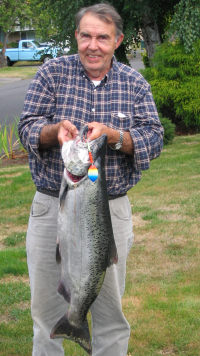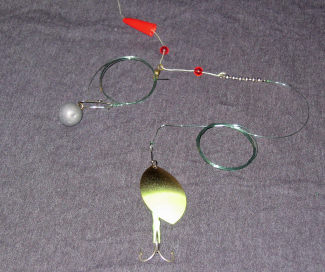
Timing the Runs and the Best Time of Day
The runs vary greatly depending on which system you target. In
general, the first systems to receive fall fish are the Nehalem,
Siletz and Nestucca Rivers. The runs begin in late August with the
bulk of the run in October and November. This can vary greatly from
year to year. Systems like the Tillamook, Alsea or Yaquina see their
run a few weeks later with the bulk in November. The number one
variable for any of these systems is rain, period.
A tide book is the key to success for day to day fishing. Learn to
read the tide book and correct for the system you will fish. Often
times there can be a 2-4 hour delay between the mouth and upper
tidewater. Your best time to target these Kings is 2 hours either
side of the low tide (the lower the better). However, do not stay at
home if the tides are not cooperating with your fishing schedule. I
have landed many fish in the middle of a tide swing. Some people
also swear by high slack. The most important thing is to make
adjustments to your gear, which I will explain later.
 Trolling
in Tight Quarters Trolling
in Tight Quarters
As I stated previously the tidewater is ideal for a small boat.
About anywhere from 12 to 18 is ideal for this fishing, although a
20 to 22 boat would work out as well. A 28 Striper is probably
not the best option. Water depth can range from 1 foot to 20 feet,
sometimes in only a few yards.
A standard trolling setup goes as follows: slider with dropper line,
beads, chain swivel, 6-8 leader, spinner. The key is to adjust
your dropper length according to the tide. On the low tide I usually
have a 10-15 inch dropper depending on water depth. As the tide
comes in I lengthen my dropper anywhere from 24-36. With more
water the fish tend to stay at the bottom. The key is to check your
rigging often; every five minutes if needed.
If at all possible I prefer to troll with the tide. One of the most
important things is to try to get your blade rotating between
115-130 revolutions per minute. You can gauge this by the bumps of
the rod (with a size 6 or 7 blade it shouldnt be a problem to feel
the bumps).
Gear
By far the most popular spinner is with the Cascade style blade. Do
not overlook the Indiana or Colorado blades, though! The most
popular sizes are 6, 7, and 8s. I prefer a size 6 or 7 in Cascade
and a 7 or 8 with the Colorado and Indiana. As far as color
combinations, everyone has their favorite. It is smart to have a few
white or pearl backed spinners for early mornings or cloudy days. In
contrast, brass, nickel or copper backs and tops are great for the
clear days. Never leave home without a few clown/rainbow blades in
your arsenal.
Leave the steelhead rod at home. You will need a rod and reel that
can handle 20 lbs. minimum; I use 30-40 lb. test. To some this seems
absurd but tidewater can be loaded with logs and various other
things that a fish can wrap around. Keep in mind these fish range
from 20-50 lbs. with an average of 25-30 lbs.
Casting from the Bank
Before I owned a boat I spent many low tides along the bank of the
Nestucca River in search for rolling fish. This method is very
popular on the Nestucca. Although under utilized in other estuaries.
The standard setup is as follows: swivel with duo-lock attached to
3-5 of leader and a spinner. I prefer to downsize my spinners for
this method (size 4-6). The reason is that you usually have to keep
the spinner and weight off the bottom with a faster retrieve. The
smaller blade will help you achieve the ideal rotation speed. I
typically cruise the banks in search of rolling salmon. If you are
convinced that fish are present stick with the area and mix up your
presentation.
Standard Gear, Tackle and Miscellaneous Tips
A sturdy bait casting setup rated between 20-50 lb. test will work
well.
|
